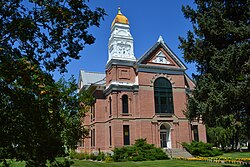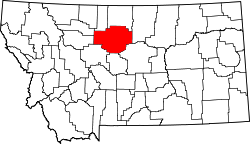Chouteau County, Montana | |
|---|---|
 Chouteau County Courthouse in Fort Benton | |
 Location within the U.S. state of Montana | |
 Montana's location within the U.S. | |
| Coordinates: 47°53′N110°26′W / 47.88°N 110.44°W | |
| Country | |
| State | |
| Founded | 1865 |
| Named after | Pierre Chouteau Jr. |
| Seat | Fort Benton |
| Largest city | Fort Benton |
| Area | |
• Total | 3,997 sq mi (10,350 km2) |
| • Land | 3,972 sq mi (10,290 km2) |
| • Water | 24 sq mi (62 km2) 0.6% |
| Population (2020) | |
• Total | 5,895 |
• Estimate (2024) | 5,880 |
| • Density | 1.484/sq mi (0.5730/km2) |
| Time zone | UTC−7 (Mountain) |
| • Summer (DST) | UTC−6 (MDT) |
| Congressional district | 2nd |
| Website | co |
| |
Chouteau County is a county located in the North-Central region of the U.S. state of Montana. As of the 2020 census, the population was 5,895. [1] Its county seat is Fort Benton. [2] The county was established in 1865 as one of the original nine counties of Montana, and named in 1882 after Pierre Chouteau Jr., a fur trader who established a trading post that became Fort Benton, which was once an important port on the Missouri River.
Contents
- Geography
- Adjacent counties
- Major highway
- National protected areas
- Politics
- Demographics
- Census-designated places
- 2020 census
- 2010 census
- Economy
- Communities
- City
- Towns
- Census-designated places 2
- Unincorporated communities
- See also
- References
- External links
Chouteau County is home to the Chippewa-Cree tribe on the Rocky Boy Indian Reservation. It contains part of the Lewis and Clark National Forest.

